Hamas attacked Israel 1 month ago. What’s happened since? : NPR
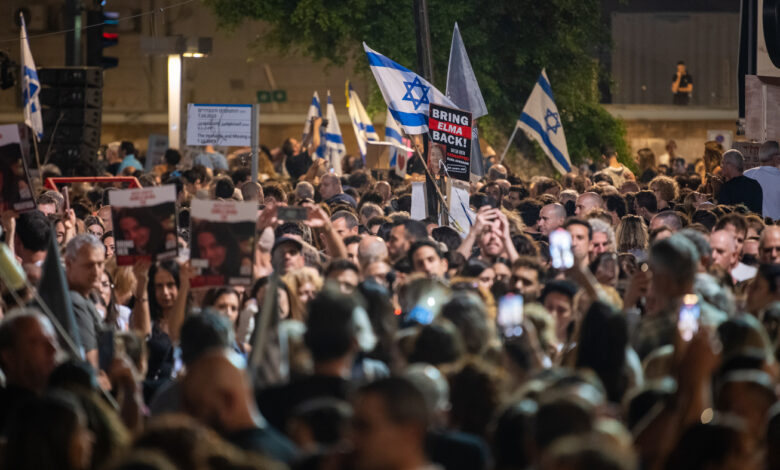
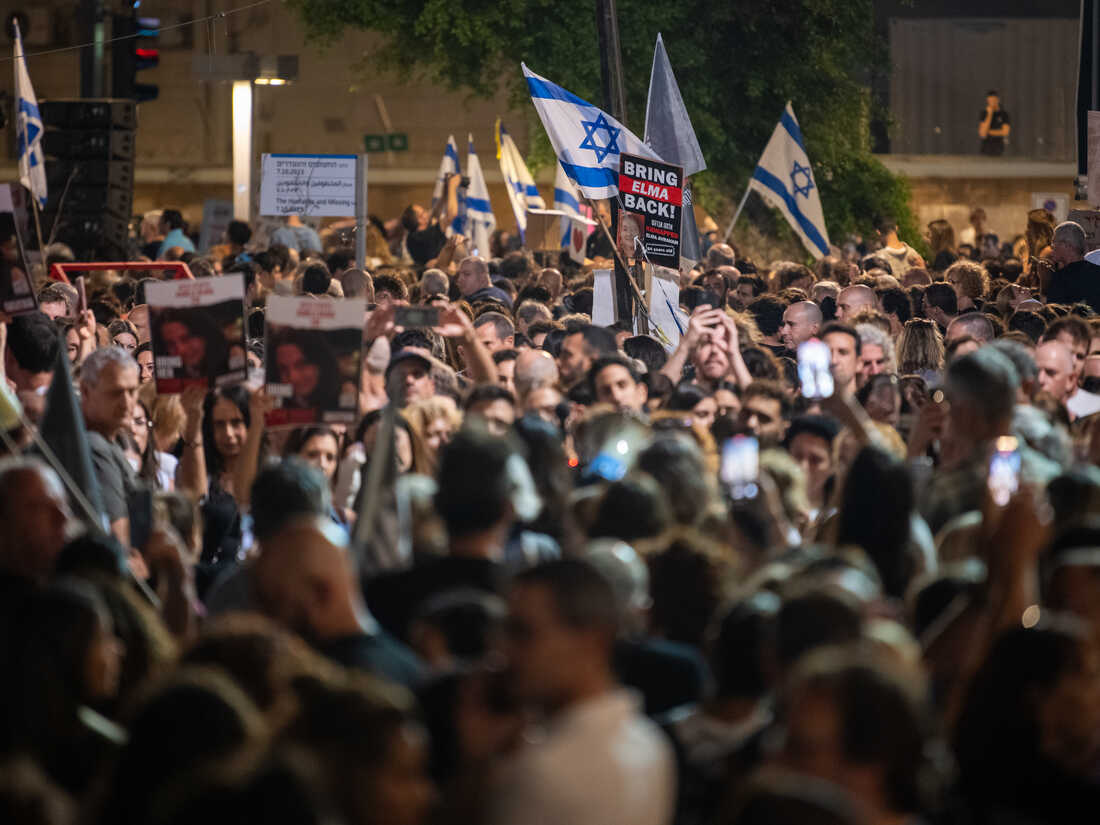
Families of kidnapped hostages join thousands of supporters in a protest at the Family of Hostages Square outside The Kiryato on Saturday to demand that Israeli Prime Minister Benjamin Netanyahu secure the release of Israeli hostagesl.
Alexi J. Rosenfeld/Getty Images
hide caption
toggle caption
Alexi J. Rosenfeld/Getty Images

Families of kidnapped hostages join thousands of supporters in a protest at the Family of Hostages Square outside The Kiryato on Saturday to demand that Israeli Prime Minister Benjamin Netanyahu secure the release of Israeli hostagesl.
Alexi J. Rosenfeld/Getty Images
TEL AVIV, Israel — A scattered group of runners hustled along the sparkling blue water of the Mediterranean Sea in Tel Aviv’s Jaffa Port early Saturday morning.
They gathered not to run for themselves, but for the more than 240 hostages still held by Hamas. Each of the runners wore Israeli flags or a race bib that said “Bring them home” and bore the images and names of individuals taken by Hamas.
That same evening, people gathered in Jerusalem and Tel Aviv for demonstrations in support of the hostages. Other protests were held criticizing Prime Minister Benjamin Netanyahu’s government for a perceived failure of properly preparing for, and reacting to, the attack by Hamas.
At a crowded rally in downtown Tel Aviv Saturday night, makeshift memorials were erected inside the plaza of the city’s art museum square honoring those still missing. Friends and families of the kidnapped and concerned Israelis wore shirts and carried signs with the names and faces of those being held hostage.
The events were held on the weekend marking one month since the Oct. 7 attack on Israel by Hamas, when at least 1,400 people were killed.
Margalit Zur, a 77-year-old Israeli woman who called for the immediate return of the hostages during the rally Saturday said her trust in her government and her feeling of safety in Israel have been shaken.
She’s unable to think of little else other than the children and babies kidnapped by Hamas, she said.
“I really can’t sleep. It’s terrible,” she said. “I can’t grasp the tragedy. It’s impossible. And I think our government shouldn’t do anything before all of them are back home safe.”
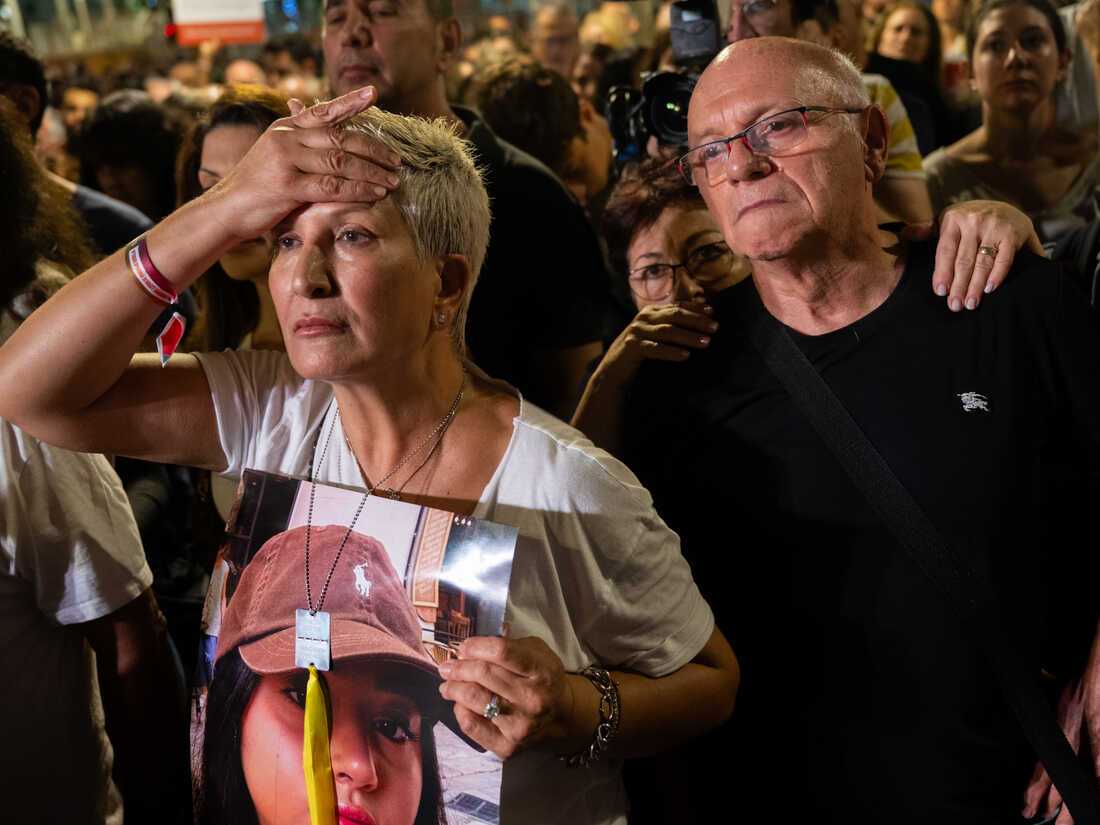
Families of kidnapped hostages join thousands of supporters in a protest to demand that Israeli Prime Minister Benjamin Netanyahu secure the release of Israeli hostages on Nov. 4, 2023 in Tel Aviv, Israel.
Alexi J. Rosenfeld/Getty Images
hide caption
toggle caption
Alexi J. Rosenfeld/Getty Images

Families of kidnapped hostages join thousands of supporters in a protest to demand that Israeli Prime Minister Benjamin Netanyahu secure the release of Israeli hostages on Nov. 4, 2023 in Tel Aviv, Israel.
Alexi J. Rosenfeld/Getty Images
In the four weeks since that attack, Israel’s intensifying military response to the Hamas attack has led to the death of almost 10,000 people in Gaza and a dire humanitarian crisis there.
There appears to be no end in sight to the now-month-old war as Netanyahu continues to reject calls for any kind of cease-fire or pause in the fighting.
“I made it clear that we are going with full steam ahead, and that Israel refuses any temporary ceasefire that does not involve the release of the kidnapped Israelis,” Netanyahu said in a statement Friday.
Here’s where things stand a month into this war between Israel and Hamas:
Palestinians are suffering the biggest losses
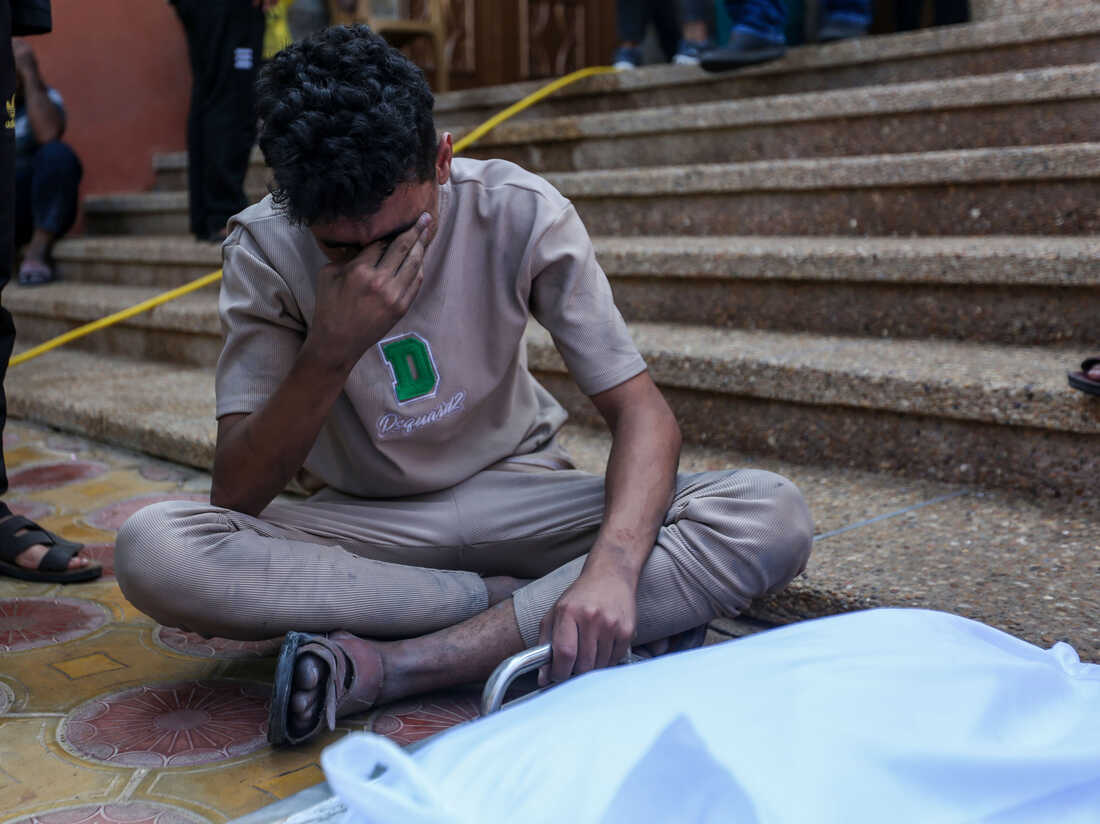
People mourn as they collect the bodies of Palestinians killed in Israeli air raids on Nov. 5, 2023 in Khan Yunis, Gaza.
Ahmad Hasaballah/Getty Images
hide caption
toggle caption
Ahmad Hasaballah/Getty Images

People mourn as they collect the bodies of Palestinians killed in Israeli air raids on Nov. 5, 2023 in Khan Yunis, Gaza.
Ahmad Hasaballah/Getty Images
As of Sunday afternoon local time, nearly 10,000 people in Gaza have been killed following Israel’s response. A majority of the killed are women and children, according to the Hamas-controlled Ministry of Health in Gaza. Almost 25,000 people have been injured and thousands of others are estimated to be missing.
Hospitals and refugee camps have been hit multiple times in Israeli airstrikes.
Israeli warplanes struck the Maghazi refugee camp in the Gaza Strip early Sunday, killing at least 33 people and wounding dozens, health officials in the region said.
The World Health Organization issued a bulletin claiming it has documented 102 attacks on health care facilities in Gaza since Oct. 7.
Hospitals that haven’t been touched by attacks are overcrowded and barely functioning due to low supplies and little to no fuel, according to the World Health Organization and the United Nations.
WHO warned this week that the bombardments, lack of food, barely working health centers and collapsing infrastructure poses particular risks for pregnant women and children.
“There are an estimated 50,000 pregnant women in Gaza, with more than 180 giving birth every day. Fifteen per cent of them are likely to experience pregnancy or birth-related complications and need additional medical care,” the WHO said this week.
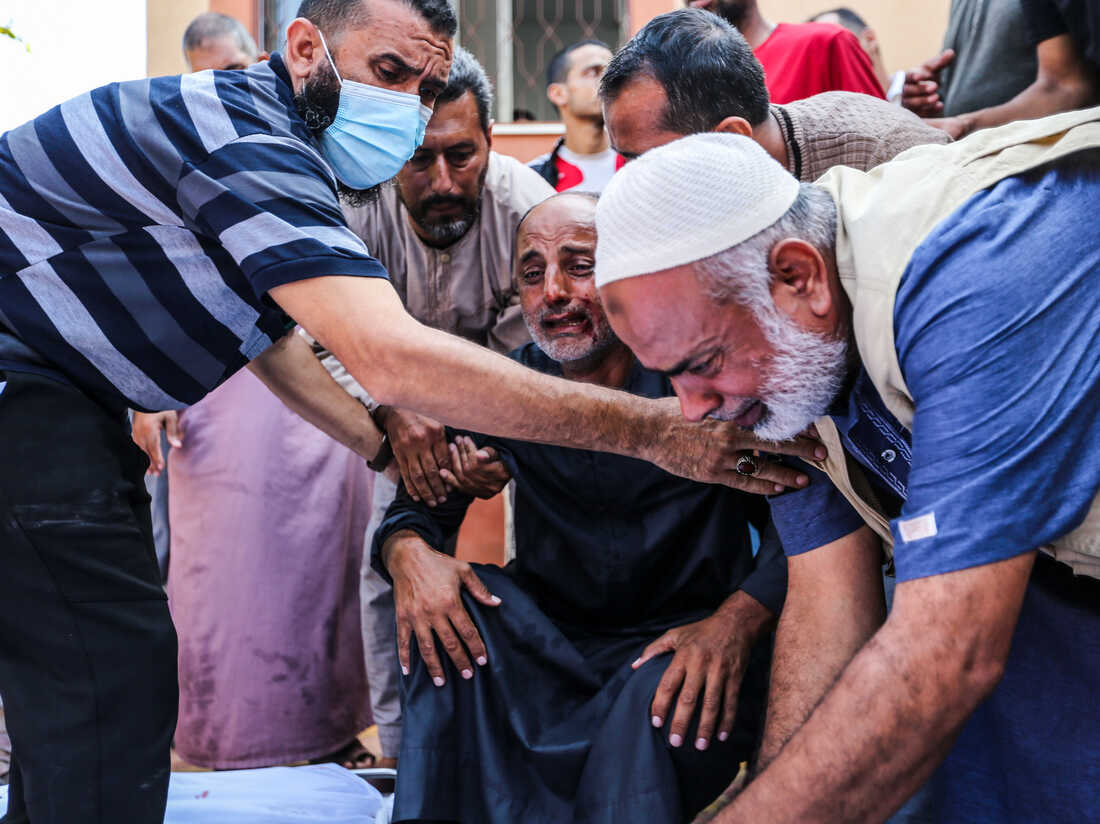
People mourn as they collect the bodies of Palestinians killed in Israeli air raids on Nov. 5, 2023 in Khan Yunis, Gaza.
Ahmad Hasaballah/Getty Images
hide caption
toggle caption
Ahmad Hasaballah/Getty Images

People mourn as they collect the bodies of Palestinians killed in Israeli air raids on Nov. 5, 2023 in Khan Yunis, Gaza.
Ahmad Hasaballah/Getty Images
Little to show for diplomatic efforts
U.S. Secretary of State Antony Blinken and other officials have been working U.S. partnerships in the Middle East to broker a deal that would allow more humanitarian aid to enter Gaza and for civilians to be protected.
He made an unannounced visit to meet Palestinian Authority President Mahmoud Abbas in Ramallah in the West Bank on Sunday following a visit to Jordan. A spokesman for Abbas said that the Palestinian president had called for an immediate cease-fire and the delivery of humanitarian aid to Gaza.
But while Blinken met with Abbas, protesters took to the streets in Ramallah and burned images of the secretary.

Protesters demonstrate against a visit by U.S Secretary of State Antony Blinken in the West Bank city of Ramallah where he met the president of the Palestinian Authority on Nov. 5, 2023.
Zain Jaafar/AFP via Getty Images
hide caption
toggle caption
Zain Jaafar/AFP via Getty Images

Protesters demonstrate against a visit by U.S Secretary of State Antony Blinken in the West Bank city of Ramallah where he met the president of the Palestinian Authority on Nov. 5, 2023.
Zain Jaafar/AFP via Getty Images
Few people stuck in Gaza have been able to leave
After painstaking negotiations between Israel, Hamas and Egypt, officials agreed to allow one border crossing to Egypt in Rafah to open, allowing some aid to enter and some foreign nationals and a few Palestinians to leave.
But officials in Gaza closed this exit this weekend, saying foreign passport holders will not be allowed to leave unless patients from the hospitals in Gaza City and northern Gaza are permitted to get to the crossing.
On Saturday, the IDF announced a brief three-hour window for the roughly 300,000 people estimated to be trapped in northern Gaza to travel safely on the road to southern Gaza. Few were able to access this so-called safe passageway.
The IDF claimed Hamas militants attacked the roadway. Hamas said the availability of a safe corridor was “a lie” and that the Israeli military was using it to attack civilians.
Aid has slowly been able to enter Gaza, but humanitarian groups have demanded more supplies to reach Palestinians.
The Palestinian Red Crescent Society reported that since Oct. 21 at least 451 trucks, around 30 per day, have been able to deliver aid through the Rafah crossing.
“However, Israeli authorities have not allowed the entry of fuel up to this moment,” the organization said.
The movements by Palestinians elsewhere have also been limited. Israeli authorities have also indefinitely paused the worker permits for the more than 110,000 Palestinians that worked in Israel or Israeli settlements.
Calls for a cease-fire grow
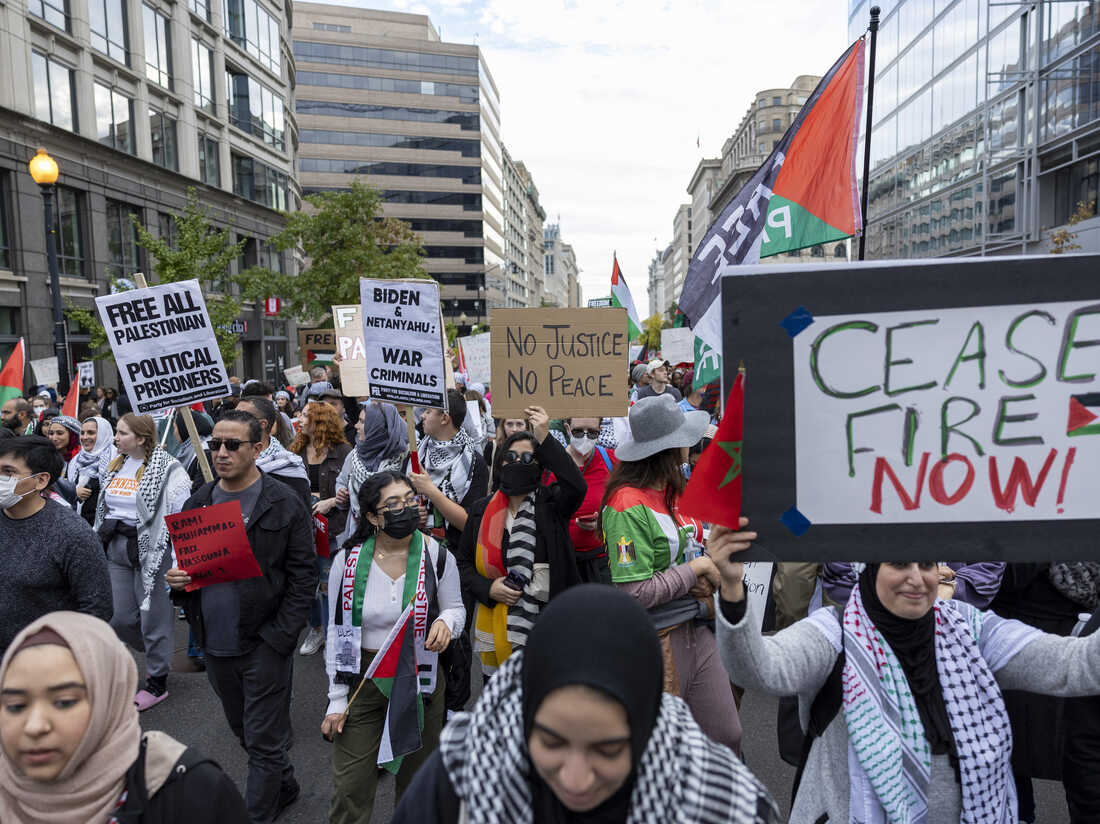
People march during a pro-Palestinian demonstration in Washington on Saturday, Nov. 4, 2023.
Amanda Andrade-Rhoades/AP
hide caption
toggle caption
Amanda Andrade-Rhoades/AP

People march during a pro-Palestinian demonstration in Washington on Saturday, Nov. 4, 2023.
Amanda Andrade-Rhoades/AP
The brutal attack by Hamas shocked Israel and the world, but Israel’s offensive in response has also stunned many in its aggression.
In a statement on Sunday morning, Israel said “over 2,500 terror targets have been struck” in the combined activities of its ground, air and naval forces in the Gaza Strip during their offensive over the past four weeks.
The IDF maintains that it targets only infrastructure it believes is housing Hamas fighters inside or in the group’s underground tunnels.
Over the weekend, communities around the world called for the end to the violence and for Israel to call for a cease-fire.
In Washington, D.C., tens of thousands of people gathered Saturday for one of the biggest pro-Palestinian protests in the U.S. since the Israeli incursion began.
The Biden administration continues to stand by Israel and its “right to defend itself.”
U.S. lawmakers still largely back Biden’s pro-Israel position
There are growing worries on Capitol Hill over the high casualty count in Gaza, but few lawmakers have publicly called for a pause in the fight.
As of early November, 18 House members have split with the Biden administration’s pro-Israeli stance and signed a resolution calling for a cease-fire.
Democratic Sen. Chris Murphy is one of the first senators to publicly express concerns over Israel’s response to Hamas, calling for a more “deliberate and proportionate counterterrorism campaign.”
“The current rate of civilian death inside Gaza is unacceptable and unsustainable. I urge Israel to immediately reconsider its approach and shift to a more deliberate and proportionate counterterrorism campaign, surgically targeting Hamas and Islamic Jihad leaders and terrorist infrastructure while more highly prioritizing the safety of civilians in accordance with the law of armed conflict,” he said in a recent statement.
Israel launched its ground offensive. What’s the endgame?
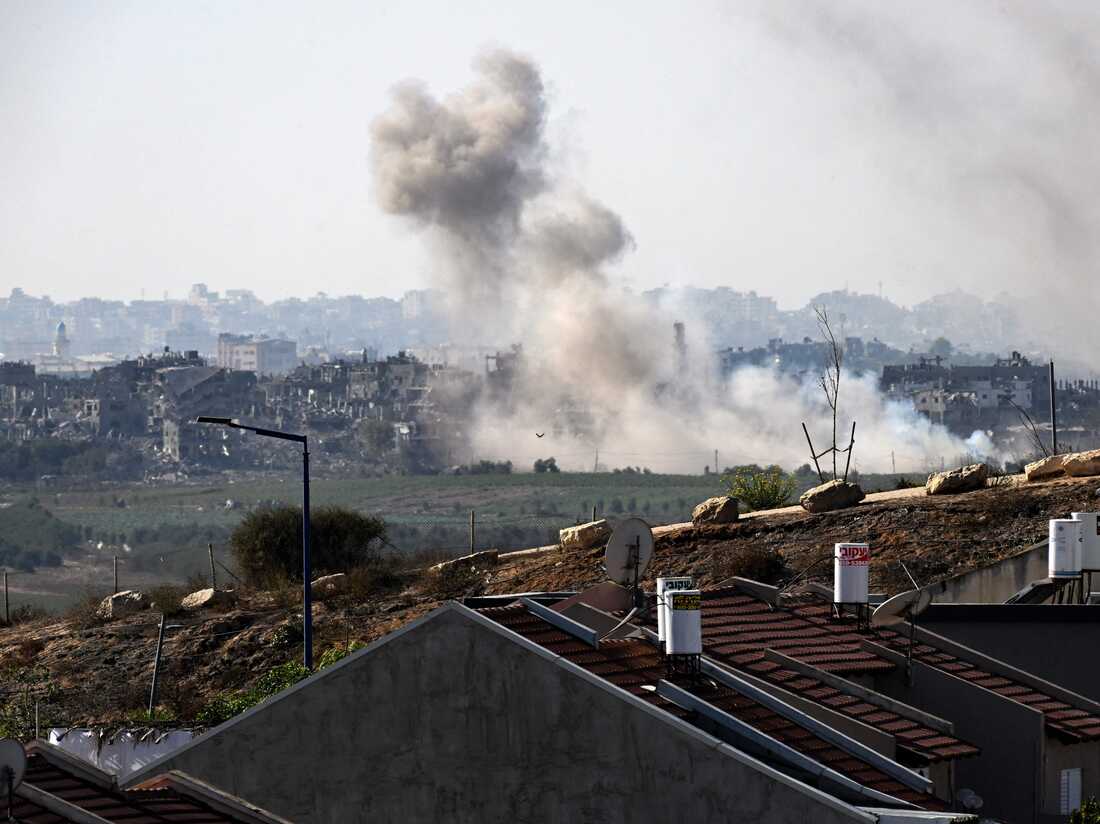
A picture taken from the southern Israeli border city of Sderot shows smoke rising above buildings in the Gaza Strip during an Israeli military operation on Nov. 4, 2023.
Yuri Cortez/AFP via Getty Images
hide caption
toggle caption
Yuri Cortez/AFP via Getty Images

A picture taken from the southern Israeli border city of Sderot shows smoke rising above buildings in the Gaza Strip during an Israeli military operation on Nov. 4, 2023.
Yuri Cortez/AFP via Getty Images
About three weeks after the Hamas attack, the Israeli government launched a military ground invasion into Gaza.
Israeli troops have swiftly taken over most of northern Gaza, and encircled Gaza City.
“Our forces are operating on all of fronts, with full power. Our victory will be decisive and clear. It will send a message to our enemies – one that will echo for generations,” Netanyahu said on Friday.
There are growing tensions along the Israel-Lebanon border as Hezbollah continues to launch rockets from southern Lebanon into Israel.
In a recent speech, Hezbollah leader Hassan Nasrallah stopped short of announcing an all-out war with Israel, but threatened that the group’s actions will depend on developments in Gaza.
The main focus of the IDF, however, remains on eliminating Hamas.
About two dozen soldiers have been killed so far in military operations in Gaza, according to the IDF.
The goal to remove Hamas is a major military challenge that will likely take two to six months, according to Yaacov Amidror, the former general and national security adviser in Israel.
Zur, the woman who attended a memorial event for the kidnapped Israelis, said her grandson is among those fighting in Gaza.
“I’m terribly worried. His mother, my daughter is broken. I mean, she’s so worried and we don’t know what’s going on,” she said.
Taking full control of the Hamas-controlled enclave may be the easy part. Finding a viable replacement to take over running Gaza, is another thing entirely.
Israel doesn’t want to do it, Amidror said.
“We don’t want to take responsibility for two million Palestinians to rebuild Gaza,” he said.
Right now, there is no clear candidate on what entity or government could potentially take on such a monumental task.










